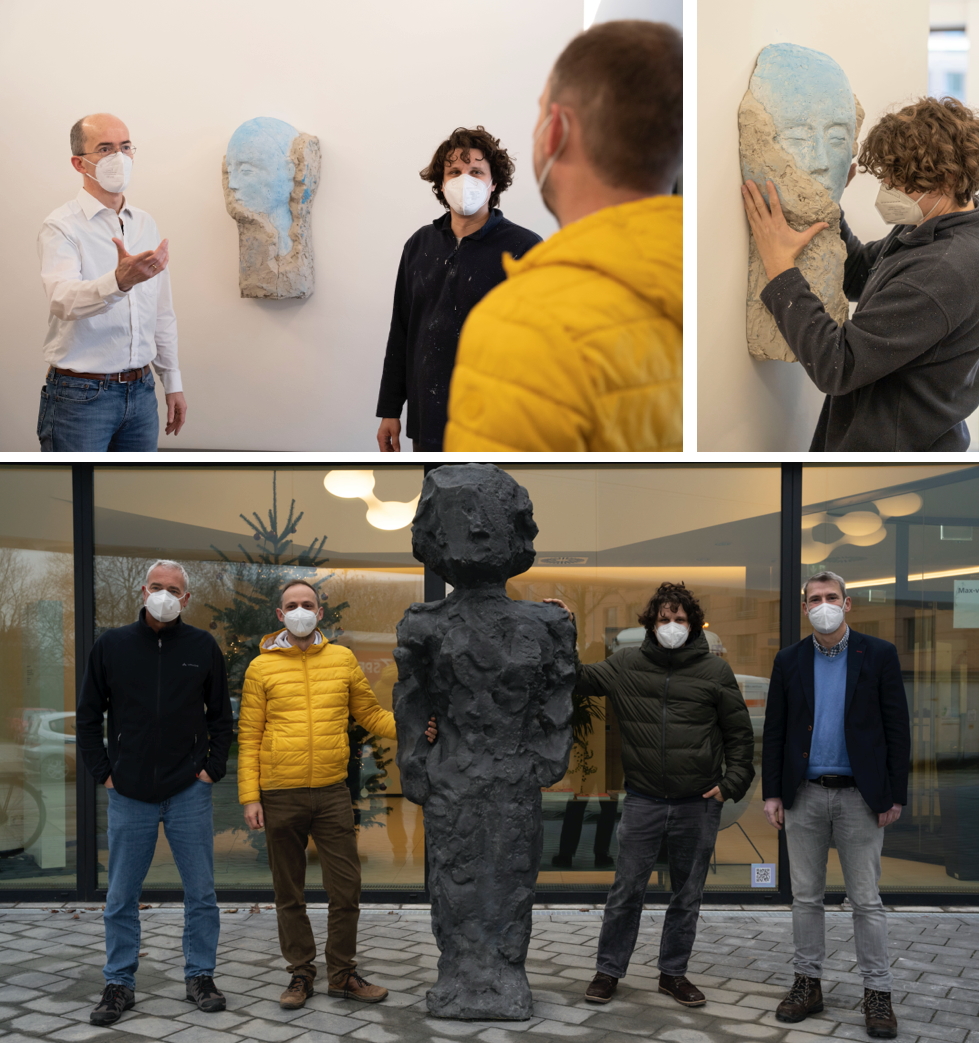Institute News

On Thursday, the sculptor and painter Daniele Dell'Eva, who works in Würzburg, gave over his work to Fraunhofer MEVIS. It was created as part of the “Kunst am Bau” (“Art in Architecture”) competition for the new institute building, the “Workshop of Digital Medicine” at the main location in Bremen. The work focuses on capturing the human body artistically and scientifically. It consists of “Menschskulptur” (“Human Sculpture”) at the main entrance, and “Three Clouds,” the three sculptural wall works mounted in the central communication areas on the building’s first to third upper floors. Dell’Eva’s approach is based on comparing problems in digital imaging and representations of the human body in sculpture. The analog fabrication processes and traditional themes from sculpture provide a counterpoint to the modern architecture of the building and Fraunhofer MEVIS’ digital research focus.
“Menschskulptur”
The starting point is a 28cm high ceramic sculpture scanned in three dimensions and enlarged to 2.30 meters using a special sand printing process and thereafter molded and cast in bronze.
A wide variety of imaging techniques can now capture ever smaller details of the human body, for example, to achieve minimally invasive interventions with great performance. Each dimension of representation has its own rules. Viewing the human body in the right proportion or in the necessary magnification plays a decisive role. This topic is taken up by the work at the main entrance: by enlarging a small sculpture, a new appearance is created. A small gesture, which can be read from the hands in the small sculpture, becomes a large movement. The relationship of this movement to the body of the modeler and the viewer changes fundamentally, but the shape and color of the surface refer to the initial ceramic figure. The patina, which imitates unfired ceramic, gives the androgynous figure an unfinished character. The work merely approximates the form of a human body and remains an open circumscription that refers to not knowing, incremental learning, and resulting new perspectives and questions. Development becomes possible when steps are dared outside of established skills and knowledge – conveyed through the lightly oversized “Menschskulptur”.
“Three Clouds”
A modeled clay head, captured and molded in three versions in plaster shells and filled with concrete and partially freed from the plaster, is the basis of the work for the communication islands in the building. Dell’Eva addresses procedures of digital medicine, such as MRI or CT, with questions of sculpture, in this case, the molding of the human body in plaster.
With the momentary and fragmentary removal and exposure of the human head form, the artist refers to digital examination methods that provide insights into the body, focusing on certain areas while other areas remain invisible. The molding process in sculpture is a moment that circumscribes and obscures the sculpture, as the form and surface are determined and recreated. The wadded-looking plaster that wraps around the head conceals the actual sculpture; added pigments highlight various gestures in the plaster mold. The title “Three Clouds” also refers to digital cloud storage on the internet that allows people to share knowledge.
“Workshop of Digital Medicine”
The new building of Fraunhofer MEVIS on the campus of the University of Bremen was occupied by the institute in May 2021 after two and a half years of construction. With 2,600 square meters of floor space, the building designed by the architectural firm Haslob Kruse + Partner accommodates up to 210 workstations. The spatial concept includes offices, seminar areas, meeting rooms, technical rooms, and individual laboratory areas and offers both retreats for concentrated work and open areas for communication and collaboration. As a “Workshop of Digital Medicine,” the building is to be seen as a driver of digital change in the health sector. It should create space to meet and discuss digital medicine. The construction costs of around 15 million euros come in equal parts from the Federal Ministry of Education and Research, the State of Bremen, and the European Regional Development Fund (ERDF).

 Fraunhofer Institute for Digital Medicine MEVIS
Fraunhofer Institute for Digital Medicine MEVIS